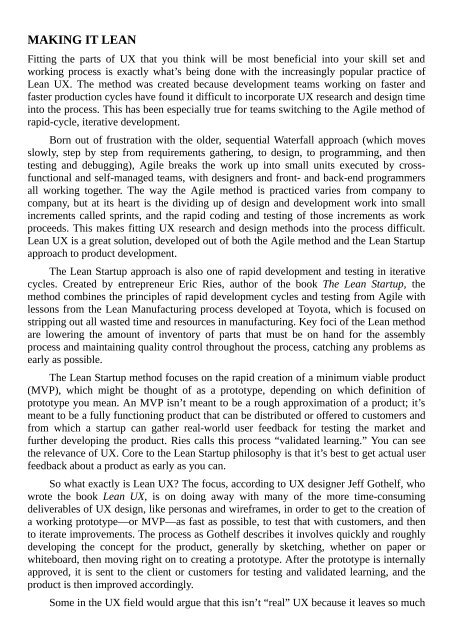You also want an ePaper? Increase the reach of your titles
YUMPU automatically turns print PDFs into web optimized ePapers that Google loves.
MAKING IT LEAN<br />
Fitting the parts of UX that you think will be most beneficial into your skill set and<br />
working process is exactly what’s being done with the increasingly popular practice of<br />
Lean UX. The method was created because development teams working on faster and<br />
faster production cycles have found it difficult to incorporate UX research and design time<br />
into the process. This has been especially true for teams switching to the Agile method of<br />
rapid-cycle, iterative development.<br />
Born out of frustration with the older, sequential Waterfall approach (which moves<br />
slowly, step by step from requirements gathering, to design, to programming, and then<br />
testing and debugging), Agile breaks the work up into small units executed by crossfunctional<br />
and self-managed teams, with designers and front- and back-end programmers<br />
all working together. The way the Agile method is practiced varies from company to<br />
company, but at its heart is the dividing up of design and development work into small<br />
increments called sprints, and the rapid coding and testing of those increments as work<br />
proceeds. This makes fitting UX research and design methods into the process difficult.<br />
Lean UX is a great solution, developed out of both the Agile method and the Lean Startup<br />
approach to product development.<br />
The Lean Startup approach is also one of rapid development and testing in iterative<br />
cycles. Created by entrepreneur Eric Ries, author of the book The Lean Startup, the<br />
method combines the principles of rapid development cycles and testing from Agile with<br />
lessons from the Lean Manufacturing process developed at Toyota, which is focused on<br />
stripping out all wasted time and resources in manufacturing. Key foci of the Lean method<br />
are lowering the amount of inventory of parts that must be on hand for the assembly<br />
process and maintaining quality control throughout the process, catching any problems as<br />
early as possible.<br />
The Lean Startup method focuses on the rapid creation of a minimum viable product<br />
(MVP), which might be thought of as a prototype, depending on which definition of<br />
prototype you mean. An MVP isn’t meant to be a rough approximation of a product; it’s<br />
meant to be a fully functioning product that can be distributed or offered to customers and<br />
from which a startup can gather real-world user feedback for testing the market and<br />
further developing the product. Ries calls this process “validated learning.” You can see<br />
the relevance of UX. Core to the Lean Startup philosophy is that it’s best to get actual user<br />
feedback about a product as early as you can.<br />
So what exactly is Lean UX? The focus, according to UX designer Jeff Gothelf, who<br />
wrote the book Lean UX, is on doing away with many of the more time-consuming<br />
deliverables of UX design, like personas and wireframes, in order to get to the creation of<br />
a working prototype—or MVP—as fast as possible, to test that with customers, and then<br />
to iterate improvements. The process as Gothelf describes it involves quickly and roughly<br />
developing the concept for the product, generally by sketching, whether on paper or<br />
whiteboard, then moving right on to creating a prototype. After the prototype is internally<br />
approved, it is sent to the client or customers for testing and validated learning, and the<br />
product is then improved accordingly.<br />
Some in the UX field would argue that this isn’t “real” UX because it leaves so much


